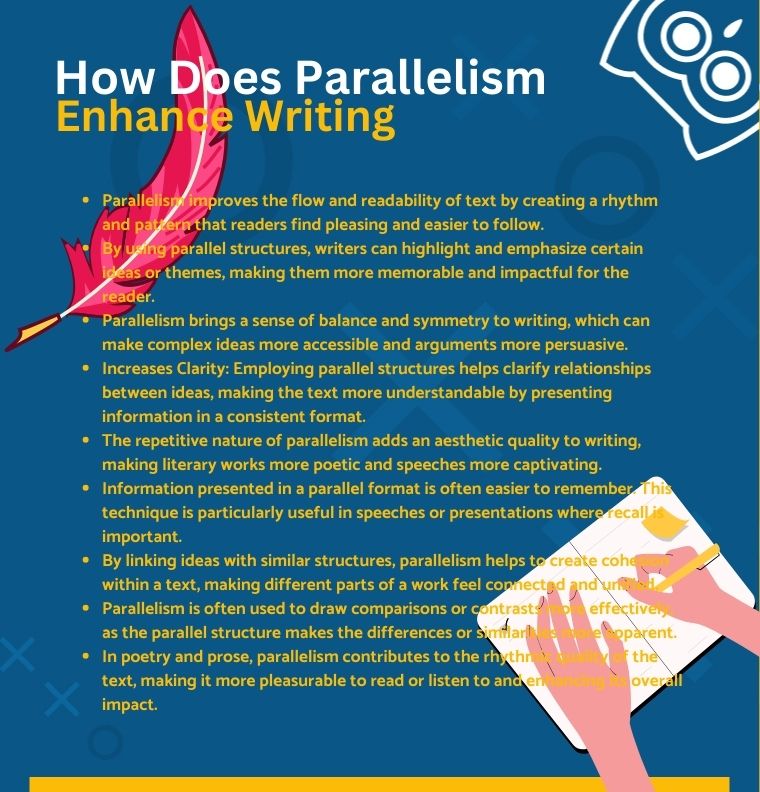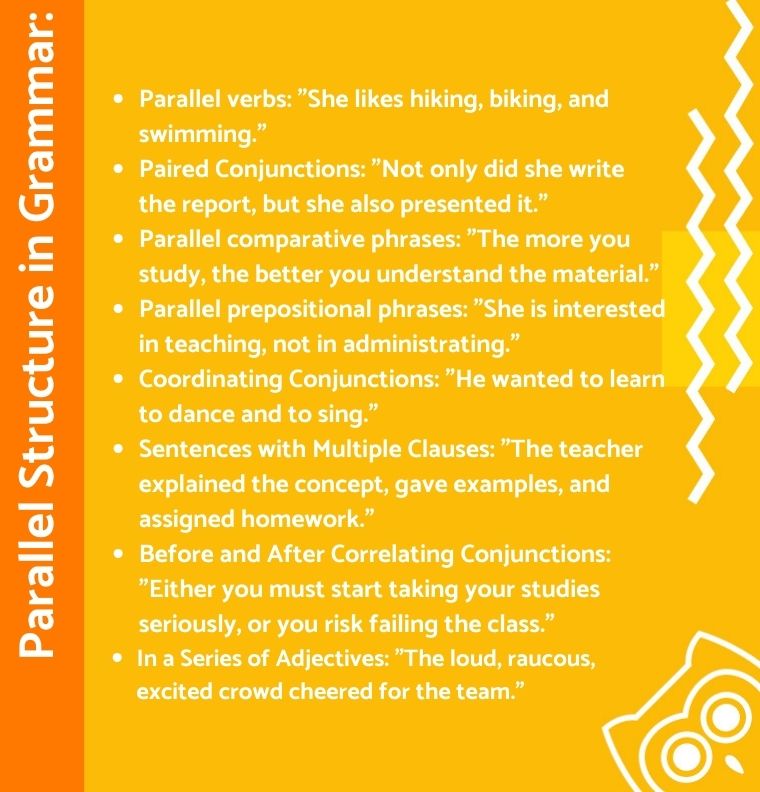Exploring Parallelism Concept in Literature and Grammar
Table of contents
The doctrine of parallelism, a cornerstone in the realms of literature and grammar, enriches texts by imbuing them with rhythm, balance, and clarity. This rhetorical and stylistic device, leveraging the power of repetition, aligns grammatical structures, patterns, or ideas to produce a coherent and impactful message.
In exploring parallelism, we journey through its applications in literary works, its critical role in stylistic analysis, the variety it introduces in grammar, and practical tips for its effective use. The essence of parallelism lies in its ability to enhance communication, whether in writing or speech, making it an indispensable tool for authors, scholars, and speakers alike.
Define Parallelism Term
Parallelism in a sentence, in both literature and grammar, revolves around the repetition of grammatical structures, patterns, or ideas to achieve a rhetorical effect. Its historical roots stretch back to ancient literary traditions, where it served as a fundamental device in poetry and oratory to emphasize points and enhance the rhythm and coherence of texts. Parallelism as a literary and rhetorical device has evolved, maintaining its significance across different eras and genres. This evolution highlights its adaptability and enduring relevance in effectively conveying messages and emotions.
Going even deeper into the realm of parallelism or faulty parallelism examples, it’s fascinating to observe its role in bridging the gap between form and meaning, enabling writers to craft messages that are not only structurally appealing but also rich in significance. The meticulous alignment of words, phrases, or syntactical structures under the umbrella of parallelism embellishes a text and fortifies its persuasive power, making arguments more compelling and narratives more engaging.
It may seem difficult to use it without professional help. And here, a skilled college paper writing service comes into play. Don’t hesitate to get assistance to show your best and learn something new. The parallelism used in a sentence or across sentences creates a pattern that appeals to the readers’ or listeners’ sense of harmony and order. Moreover, parallelism’s presence in speeches and literary works often serves as a mnemonic device, aiding in the retention of information and making the content more memorable.
The Meaning of Parallelism in Literature
What is parallelism in literature? The types of parallelism in literature, its intricate weave through the fabric – be it in the direction of the rhythm of poetry, the flow of prose, or the persuasive force of rhetoric and theory – acts as a cornerstone for enhancing narrative depth and argumentative clarity. If we have to analyze poetry, the examples of parallel structure in literature find their roots in the structured cadences of Shakespeare’s sonnets. Each line there echoes with balanced symmetry, and extends to the persuasive speeches of ancient rhetoricians, whose arguments gained strength from the deliberate repetition of structure. The tendency of artful deployment of parallelism by authors across epochs and genres serves not merely as an aesthetic choice, but as a powerful tool for embedding themes and motifs within the consciousness of their audience. It does so by creating a resonance that both harmonizes and highlights, making the literary work not only more coherent but also more impactful.
This impact is felt in the rhythmic quality that guides the reader through the text, in the coherence that binds disparate ideas with a common thread, and in the memorable nature of the prose or verse. It lingers long after the last page is turned. Parallelism, therefore, transcends mere stylistic preference, emerging as a vital element that contributes to the lasting legacy of literary texts. Through its use, writers masterfully weave a tapestry of words that captures the essence of their message, ensuring that their works resonate with readers across generations.
Parallelism in Stylistic Analysis

In stylistic analysis and literary criticism, parallelism serves as a lens through which scholars and critics examine literary works. This critical analysis often reveals deeper themes, motifs, and rhetorical strategies, underscoring the device’s importance in interpreting texts. Through the lens of parallelism, the nuanced interplay between form and content becomes more discernible, allowing for a deeper understanding of the author’s stylistic choices and the work’s overall communicative effect.
In stylistic analysis, parallelism is scrutinized not just for its aesthetic appeal but for its role in reinforcing themes, motifs, and rhetorical strategies. For instance, the repetition of sentence structures or phrases often mirrors the thematic repetition in the narrative, thereby enhancing the text’s thematic unity and emphasis. Scholars such as Robert Alter have highlighted the use of parallelism in biblical literature, noting how this technique contributes to the poetry’s evocative power and narrative depth. The analysis of Martin Luther King Jr.’s speeches reveals how the use of similar structures to express similar ideas serves not only to captivate and persuade the audience but also to imbue the discourse with a profound moral urgency.
Critics also explore how parallelism facilitates the conveyance of complex ideas and emotions in a more accessible and impactful manner. By creating a repeated grammatical pattern, authors can guide readers through intricate arguments or emotional landscapes, making the abstract more tangible and the persuasive more forceful. For example, in the analysis of Virginia Woolf’s prose, scholars point out the use of parallelism vs parallel structure to mirror the characters’ internal conflicts and societal critiques, thereby enriching the narrative’s psychological and sociological dimensions.
Furthermore, parallelism’s contribution to the rhythm and coherence of texts is a subject of significant scholarly interest. What is parallel structure? In poetry, the strategic use of parallel words can enhance the musical quality of the verse, while in prose, it can provide a rhythmic cadence that propels the narrative forward. This aspect of parallelism affects the reader’s sensory experience and plays a crucial role in reinforcing the work’s thematic resonance and structural integrity.
Parallelism examples in writing of scholarly interpretations underscore its significance across genres and periods. From the epic similes of Homer’s “Iliad” to the intricate verbal patterns of modernist poetry, parallelism emerges as a key element in the stylistic innovation and thematic development of literary texts. These analyses reveal how parallelism, beyond its surface function, acts as a conduit for deeper meaning and stylistic complexity, thereby affirming its essential role in the literary arts. Through scholarly exploration, the significance of parallelism is illuminated not only in enhancing the aesthetic and rhetorical qualities of texts, but also in deepening our comprehension of literary works’ thematic and stylistic layers.
Types of Parallelism in Grammar
Parallelism in grammar can be observed in different forms, such as parallel clauses, phrases, and parts within sentences. These types create balance, symmetry, and punctuation rules, enhancing the sentence’s readability and comprehension. Understanding the different types of parallelism helps writers and speakers craft sentences that are not only grammatically correct but also rhetorically effective. The diversity of parallelism types, such as antithetical parallelism, where contrasting ideas are expressed in a balanced format; syntactical parallelism, which aligns sentence structures for emphasis; and lexical parallelism to correspond and repeat specific words or phrases, enriches language use by offering a variety of expressive tools.
This variety allows for nuanced expression that can adjust the tone, pace, and mood of the text, making it more dynamic and engaging. For instance, the use of anaphora, a specific type of parallelism syntax involving the repetition of the same word or phrase at the beginning of successive clauses, can imbue a piece of writing with a persuasive or poetic quality. Additionally, the strategic employment of parallelism in argumentative writing strengthens the argument by making it more coherent and easier for the audience to follow. Lastly, in the realm of public speaking, the adept use of parallel structures can significantly enhance the speaker’s ability to connect with the audience, leaving a memorable and lasting impression.
Parallelism Sentence Examples in Grammar

Parallelism in grammar shines through in various sentence constructions, providing clarity and enhancing the flow of ideas. An example of this can be found in the symmetry of lists: “She likes reading, writing, and skiing.” Here, parallelism ensures each item in the series matches in grammatical structure, offering a smooth, easy-to-follow progression of hobbies. Another illustration is in contrasting ideas with parallel structure in English: “Not by might, nor by power, but by my spirit,” where the repetition and parallelism of structure emphasizes the contrast and delivers a powerful message. In narrative prose, an author might use parallelism to build suspense or draw comparisons: “The storm raged outside; inside, the children’s laughter echoed.” This juxtaposition of external chaos with internal joy is made more poignant by the parallel construction example of the clauses.
Additionally, speeches often employ parallelism to inspire or persuade: “Ask not what your country can do for you – ask what you can do for your country.” Here, the parallel syntax makes the phrase memorable and underscores the call to action. Through these examples, the utility of parallelism in enhancing readability, emphasizing points, and enriching the text’s rhythm and coherence becomes as a new testament, demonstrating its indispensable role in effective communication.
Practical Tips for Using Parallelism
Incorporating parallelism into writing requires an understanding of its forms and functions. Practical tips and guidelines help writers apply parallelism effectively, ensuring that their messages are conveyed with clarity and stylistic finesse. From crafting a persuasive essay to delivering compelling speeches, parallelism remains a key element in effective communication. Incorporating parallelism into your writing or speaking can significantly enhance clarity, coherence, and impact. To effectively utilize this stylistic device, consider the following practical tips:
- Ensure all items in a list share the same grammatical form. This creates a rhythm and makes information easier to process. For instance, if listing actions, keep all items in the same verb form.
- When presenting contrasting ideas or comparisons, use parallel structures to highlight the differences or similarities. This technique can emphasize the contrast and make your argument more persuasive.
- Use repetition of phrases or structures at the beginning or end of sentences to underscore important ideas. This draws attention to these points and aids in retention.
- When using rhetorical parallelism, follow them with parallel structured answers to provide emphasis and clarity to your argument or narrative.
By adhering to these tips, writers, and speakers can leverage parallelism to craft messages that are not only more aesthetically pleasing, but also more effective in conveying their intended meanings. You can do it yourself, or order essays from professionals to see how it works. Parallelism, when used skillfully, can transform simple messages into memorable and impactful communications, enhancing both the delivery and the reception of the ideas presented.
Importance of Parallelism in Communication
The significant link of parallelism in communication cannot be overstated. It enhances persuasive writing and speeches, elevating discourse by making it more engaging and memorable. In both written and spoken language, parallelism serves as a powerful tool for conveying ideas succinctly and powerfully, highlighting its essential role in effective communication. In conclusion, parallelism stands as a pivotal element in literature and grammar, offering a pathway to more dynamic and impactful communication. Its application, spanning from ancient texts to modern narratives, illustrates its versatility and enduring relevance. By understanding and utilizing parallelism, writers, and speakers can elevate their craft, ensuring that their messages are not only heard but also felt.






